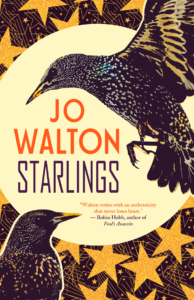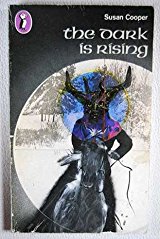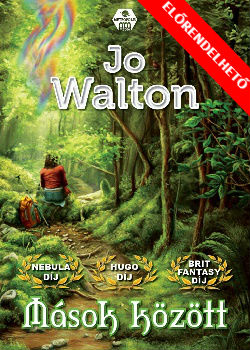When we moved to Montreal, my son was eleven. He happened to find an old, 1920, book in a thrift store called something like Science Today, which was an overview of the cutting edge of science as of 1920, with exciting old black and white photos of things like the first electric streetlights in Canada. It had chapters on different subjects of scientific interest. He started reading it, and asking my husband questions about how out of date it was, and what had changed since it was written. This became an activity, where my son would read a chapter, and then my husband would go through it with him talking about how our understanding of electricity, or atomic theory, or biology, had changed since the book was written. This was immensely valuable because it didn’t just teach him science, it taught him that science is a constantly changing process, not The Truth but constant experimental attempts to discover how the universe works. Learning it this way was both fun and very effective, and he learned far more both facts and what science is than he did in school science classes. If people are stuck at home looking for ideas for teaching science to their kids this might be worth a try, and it’s easy. Old popular science books tend to be available for next to nothing, and the current state of the field can now be found on Wikipedia.
- Home
- About Jo Walton
- Books
- Podcast
- Poetry
- Love, Pain, and Death
- A happy morning filled with pears
- And love
- Because you need your sleep (a very short love poem)
- Belated Valentine
- Bittersweet Harvest
- Black Figs at the Villa d’Este, 28th August 2014
- Blood and Bone
- Comfort In the Knowledge
- Conquering Sleep
- Death Sucks: A Sonnet Cycle
- Death Continues to Suck
- Death Sucks #5750
- More Sting
- Journey
- On the Death of Danny Lieberman
- Grief
- Jay Lake 1964-2014
- Death Just Sucks
- On the Death of Marilyn Bremmer
- Negatio Mori
- Words of Comfort and Cheer (On the Deathbed of Greer Gilman’s Mother)
- On the Death of Beth Meacham’s Father
- Statistical Death Sucks
- The world does not stay saved
- Secular Humanist Comfort
- Epicurean Death Sucks
- On the Death of Louise Mallory’s Mother
- David G. Hartwell, 1941-2016
- On the death of Spider
- On the Death of Velma de Selby Bowen
- On the impending death of Morris Keesan
- Yarnell Fire
- On the Impending Death of Iain Banks
- On the Death of Dr Michael Matthew Fiveash
- Viking Ship Museum, Oslo
- Doing Laundry on the Last Day of the World
- E. Jane Jones 1923-2015
- Evensong
- Fabio Picchi 1954-2022
- Friends
- Galatia
- Gill Goodridge 1926-2022
- Henry Ellis “Harry” Hoad, 1897-1917
- Hope Eyes
- I want…
- If the living do not remember the dead, who will?
- Jenna Felice 1976-2001
- John M. Ford Memorial: 27th October 2006
- John M. Ford Sestina
- Joy of Libraries
- July 1911
- Just a moment
- K Poem
- Keeping Going
- Lies About Pain
- Litany for Being Centered Through Pain
- Married Love
- Michelangelo, 1475-1564
- Next Time I Fall in Love
- Next Time I Fall in Love 2: For Laurie Penny
- Night Thoughts
- Non Serviam
- Obsessed with Petrarch
- Pain lacks plot: Haikus
- Pegasus
- Petrarch and Laura
- Samian bowl
- Secular Humanist Hymn
- Shafts of Sunlight
- Sleepless in New Orleans
- Sometimes the sky is empty
- Sophoniba
- Spiral Sestina
- The Death of Petrarch
- The Grief of Apollo
- The Hoard
- The Muse Comes Back
- The Purpose of Sonnets
- The Soft Arguments of Time
- Time Machine
- To a young girl crying on the bus
- Unbound
- Unheard Sonnets
- Ursula Le Guin
- Ursula le Guin 1929-2018
- Vast, Fleeting
- Veiled Language
- Verre/Vair
- Vicious Nexus
- Vivi per Sempre
- What Persephone Knew
- What to do with a crush?
- When Everything Spirals Down
- When You Dance
- New Myths for Old Gold
- A Fine Italian Hand
- A Glimpse of the Muse on Papineau
- Advice to Loki
- An Oracle from Dionysos
- Anchises
- Andromache
- Another Oracle from Dionysos
- Ask to Embla
- Ayfa’s Song
- Bookstores of Heaven
- Candlemass
- Carnival Dragons
- Cassandra
- Electra to Orestes
- Eucatastrophe Poem
- Fisher King
- Footfall (translation of Cavafy)
- Grendel, Again
- Hades and Persephone
- I just changed one letter!
- In Death’s Dark Halls, a Dog Howls
- Is This the Face?
- Jane Austen Among the Women
- Keeping an eye out
- Le Morte de MacArthur
- Leap Saints
- Lion Mother
- Mary Madgalen
- Medusa
- Milton in Heaven
- Nemi
- New Hope Woman
- Nine Things About Oracles
- Not in this town
- Odin on the Tree
- Owl Mother
- Sappho beyond Hades
- Sibyl
- Sky Woman
- Still Odin
- Still Odin
- Susan
- The Assumption of St Jerome
- The Chocolate Tarot
- The Conception of Cuchulain
- The Death of Llacheu ap Arthur
- The Devil’s Party
- The Ghosts of Time to Come
- The Grief of Orpheus
- The Love and the Oath
- The Magic Animals of Heaven
- The Ragnarok Song
- The Weatherkeeper’s Diary
- Twelve Missing Scenes From the Life of the Virgin
- Yo, Bacchus!
- Zedekiah in the Inner Chamber
- Red as Blood
- A Plausible Guess
- After the Spindle
- Blood Poem IV
- Cendrillion Sunrise
- Dragon’s Song
- Lake Wife
- Mari Llwyd
- Night on Cadair Idris
- North Wind
- Off With the Fairies
- Postcolonial Literature of the Elves
- Raven Prince
- Scorpio
- The Cloud Mouth
- The Head
- The Lessons of Fairytales
- The Old Queen
- Three Bears Norse
- Two Trolls and a Princess
- What do Elves Smell Like?
- What Dragons Learn From Fairytales
- What Story Would You, Sir?
- Wyrms
- Shakespeare
- Alternate Hamlet Sonnet
- Arthur’s Bosom
- Cardenio
- Henry V Part II
- Machiavelli and Prospero
- Oregon Shakespeare Festival to rewrite Shakespeare
- Stage Vs Screen
- The Baseless Fabric of This Vision
- The Poly Winter’s Tale
- Thirteenth Night
- This Spring, in Elsinore
- To Shakespeare on his four hundredth anniversary
- Wittenburg: A double sonnet
- The News
- “Pax in forma columba”
- 1947
- 9th November 2016
- A tangle of wires
- American Dream
- Ares and Athene
- Asa Loki, Under Glacier (Eyafjallajökull)
- Between the li(n)es
- Britannia
- Calamita d’Italia, two translations
- Car Parks and Kings
- Cold Autumn Gales
- Desmond
- George Fox
- Grim Dystopian Mazurka
- Henry Kissinger 1923-2023
- History is easy
- Home Photos
- How to Hide Treasure (For Khalid al-Asaad, 1932-2015)
- In Time of Plague: Saturnalia
- King George is Dead
- Make Earth Great Again
- Mall Poem
- Moloch
- Neighbours: Traditional Vernacular British Poem About Brexit
- New Orleans Talking Blues
- Not the Christmas Poem You Were Looking For
- One of the victims was a ninety-seven year old woman
- One Simple Thing
- Posterity
- Routine Morning
- Ten Years Ahead: Oracle Poem
- Terrible People
- The Flight Into Egypt
- The news
- The Shell
- The women outside the wall
- To a friend planting bulbs today
- Today you told me that the wolves came back
- Today you told me that the wolves came back
- Truth on Life Support
- Tsunami
- USA 2018
- Villanelle
- Vulcan’s Forge
- Wayside Morning
- F*k* News
- By Their Spaceships Ye Shall Know Them
- Alien Landing
- An Old Poet Sees a New Star
- By Their Spaceships Ye Shall Know Them
- Cave Painters, Starship Dancers
- Earth
- I Reinvent Myself From Time to Time
- My Mother Was a Methodist, My Father Was a Knife
- Newton and Cromwell
- Newton’s Dream
- Nine Things About Heraclitus
- People, Tech. Glory etc.
- Photons
- Pleiades
- Scientific Method
- Submersible Moonphase
- The Winter Road
- Through the Green Fuse
- Translated from the Original
- Under the Frond Trees
- Water on the Moon
- What Gods May Come?
- When We Were Robots in Egypt
- Places and Travel
- A Foggy Morning in Esperanza Springs
- Allegory of Good and Bad Government
- Another Valley
- Bargello
- Early Morning, Saint Malo: Two sonnets
- Earth (for Greer)
- English Cemetery, Florence
- Flying By Night
- Hymn to Sardinian Apollo
- Iceland (Day 2)
- New Mexico Train Haikus
- Next Talking Fish, Five Hundred Miles
- Not a Selfie
- O City, City
- Paris
- Prayer to Hermes
- Salt and Alabaster
- Sketching the Cloister of Santa Croce
- Sonnets at the Source of the Sorgue
- Spain Train Haikus
- Starlings in Rome, November 2022
- The Pantheon
- The Vendors of Via dei Cerchi
- Three Stops in Italy 2021
- Travel Planning
- Typhon at Ischia
- Unnecessary Journeys in December
- Unnecessary Journeys in December 2
- What the Old Stones Say
- Zephyr Moon
- Eastward Zephyr Haikus
- Jardin Botanique 17th April 2013
- Zephyr Haikus (Things seen from the train 8th-10th March 2016)
- Visiting France
- Come if You Like
- Adirondack Poem
- The Turning Year
- Solstice 2017
- Happy New Year
- A surprisingly long cake making poem
- Moments
- February 15th
- Another Poem About the Weather
- Venial Joys
- Guy Outside Vendome Metro Handing Out Free Papers (trans)
- Suddenly, Spring
- Amroth III (Conversation with the Sea)
- Jardin Botanique October 3rd 2005
- The Real Season
- Seasons Readings
- Plea for Inclusivity in Nativity Scenes
- The Hopes and Fears of All the Years
- In Winter’s Heart
- Whimsy
- A Feminist Perspective on Glaciation
- A Game of Consequences
- Alarm Clock, see Zephyr (an imaginary index)
- Alessandro Farnese
- Allegory
- Antiquity
- Apep, the Snake God
- Begin to Learn to Read the Sea
- Blood Poem V
- Crow on the Orient Express
- Dialogue
- Dinosaurs Rarely Pray to Athena
- Do Not Use N95 in Space!
- Emily Dickinson’s “Howl!”
- For Louise
- From a Found Typo
- Happy Birthday, Sherwood Smith!
- Imaginary Internet Friends
- In the Room the Women Come and Go
- Interviewing the Sky
- Jane Austen and Canute
- JCB
- Joy of Reading
- Lions Vs Martyrs (What? What?)
- Lucy/Selendra
- Nonsense Sonnet
- Nonsense!
- Off With Jack
- On the compositional methods of Ada Palmer
- Overrated
- Ovid in Exile
- Ponty Market
- Proud Sappho
- Rejoice!
- Spam Poetry
- St Francis Preaches to the Animals
- The Destruction of Woking
- The End of the World, in Duxford
- The Godzilla Sonnets
- The Lurkers Support Me In Email
- The Snows of Coney Weston
- Time catches up with art catches up with time…
- Time Travellers
- Tolkien’s Refutation of Plato
- Unusual Chameleons
- Usenet 25th December 2006
- Warre
- Where You Met Me
- Yet Another Story ID
- You said you sat for a bit, you didn’t say you wrote a poem!
- “Perhaps the horse will learn to sing…”
- Love, Pain, and Death
- Recipes
- 1: Sirens
- 2: Ideal Chocolate Cake
- Apricot loaf with cinnamon and saffron
- Autumn Apple cake (Torta di mele)
- Awesome Orange Cookies
- Blood Orange Cake
- Butter Tarts
- Cakelings
- Carcofi pie
- Carrot Soup
- Cassoulet (Very easy)
- Cheese and Bacon scones
- Cheesecake (easy)
- Chicken liver pate with apple, mushrooms, garlic and red wine
- Choc-chip Ricotta Cake
- Chocolate brownies (very easy)
- Clafouti
- Cousin Beryl’s Fruitcake
- Finnish Mushroom Quiche (easy)
- Fleur de Sel Chocolate and Raspberry Bars
- Holy Grail Cookies
- Italian grape cake (Schiavona ala uva)
- Italian Ricotta Meatballs
- Lamb and Barley Casserole
- Maple Walnut Brownies
- Mince Pies
- Mushroom Soup
- Nutroast
- Onion and Tarragon Quiche
- Raspberry Muffins
- Rhubarb Crumble
- Roast Chicken
- Scones
- Shortbread
- Spanakopita (really easy)
- Spiced Peach Tarts
- Summer Roast Chicken (incredibly easy)
- Vegan Berry Cakelings
- Vegan Cassoulet
- Vegan Choc Chip Spiced Stollen (really easy)
- Yo Ho Ho Scintillation Fruitcake
- Yokki
- Short Stories
- Plays
- Privacy Policy
- Blog
- Translations
- Photo of the day








